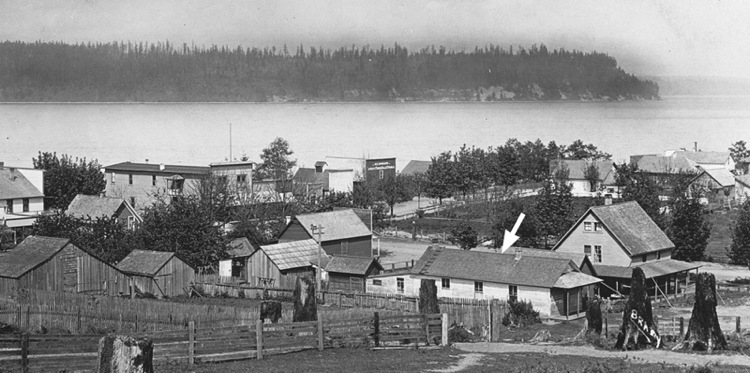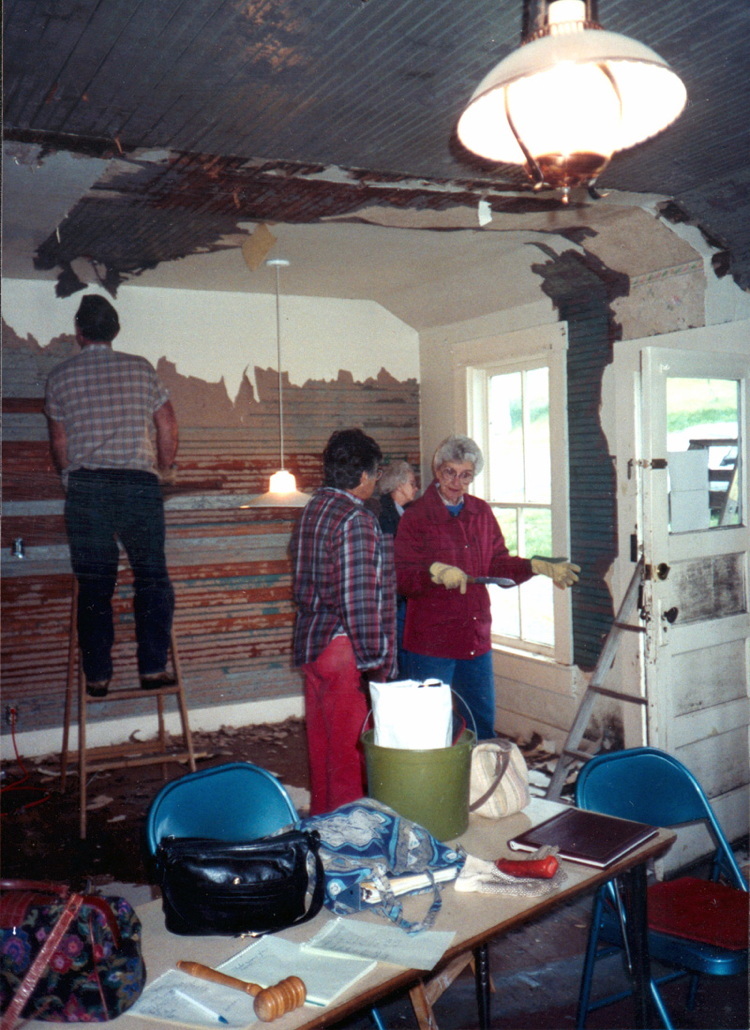
312 Second Street
South Whidbey Historical Society Museum (Bunkhouse/ Residence)
1900: Bunkhouse built

1911. Downtown Langley as seen from Second Street. Bunkhouse (arrow). (Courtesy South Whidbey Historical Society)
The structure was built by Jacob Anthes, the founder of Langley, WA, as a bunkhouse/cookhouse for his employees sometime around the turn of the 20th Century, but the exact construction date is unclear. Although the date 1902 has been suggested, there is evidence that the actual date was earlier. Lorna Cherry gives that date as 1890 in an1889 article in the South Whidbey Record. This seems plausible because the major logging off of the town site and supplying cordwood to the mosquito fleet steamers was an important occupation in the years immediately following the platting of the town site in 1891.
In a letter to George Kellogg dated February 21, 1930, Jacob Anthes wrote, "The call for wood (for the steamers) was immense. In the years 1891 to 1893 our wood sales averaged fully 35 cords a day. In order to fill the demand, seven teams of horses and twenty-five wood choppers were required."
This would seem to indicate a need for housing these men during these years, although some may have been housed in a small cabin on Triangle Road or elsewhere.
The need for cordwood was reduced following the economic depression of 1893 but revived following contracts to supply brush for rip rap for construction of the Great Northern railroad pier in Seattle's Smith Cove after the Yukon gold rush started in 1897.
Whether the bunkhouse was used to house loggers/brushcutters during this period is not clear, but the bunkhouse began to be occupied by people coming to Langley needing a place to live while building their homes. For example, Roderick and Sarah McLeod stayed there in 1903 while building the Howard Hotel with Sarah’s father, Ed Howard indicating that the need for a bunkhouse for loggers was past.
The building was purchased by the town blacksmith Anton Myre ("Blackie") Anderson in 1905. Members of the Anderson family lived in the building or rented it out until 1989 when it was donated to the South Whidbey Historical Society following the death of Alma (Anderson) Grist.
At some point, the front porch was removed, the main door was relocated to the west side, and a kitchen was added on the north side.

Circa 1989. Bunkhouse before remodel (Courtesy South Whidbey Historical Society)
1992: South Whidbey Historical Society Museum opens.

1992. Historical Society members remodel the bunkhouse (Courtesy South Whidbey Historical Society)
Historical Society volunteers refurbished the interior and opened the bunkhouse as a museum in 1992.

1994. Museum following remodel (Courtesy South Whidbey Historical Society).

2016. South Whidbey Historical Museum (Courtesy Robert Waterman)
In 1996, the floor of the museum fell past its joists and hit the ground. A major reconstruction occurred during 1997 and 1998. Original features like the front porch and Second Street entrance were restored. An office, storage space, and a concrete foundation were added, and wheelchair access was completed. The museum re-opened in December of 1999 with new exhibit spaces designed by Lee Wexler.
A statue of a brush cutter by Georgia Gerber was placed in front of the museum to commemorate the early loggers and brush cutters.